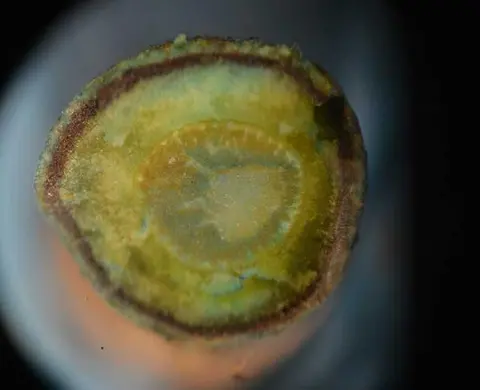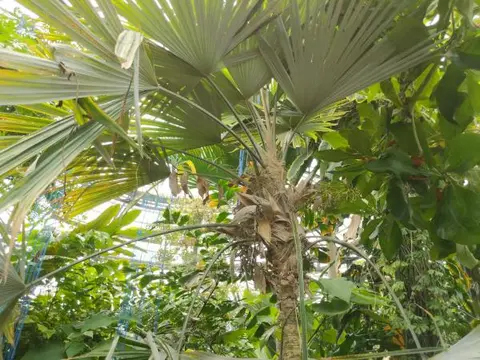Cryosophila albida - Body
Deep in The Huntington’s conservatory grows a remarkable plant! This plant’s scientific name is Cryosophila albida. Look closely at the photos and videos below. What do you notice? How do you think this plant has adapted to survive in its environment?
Cryosophila albida
Scientific name: Cryosophila albida (kry-o-so-FEE-lee-uh al-BEE-duh)
Family: Arecaceae
Common Name: N/A (this plant does not have a common name)
Range: Costa Rica, Panama
Cryosophila albida
Armor. Spines protect the plant from hungry and thirsty animals (including humans). Animals need water and nutrients to stay alive. Plants are a great source of water and nutrients for animals, but plants need to hold onto their own water and nutrients! Armor is an adaptation to protect the plant from hungry animals. The spines also provide shade to this desert plant.
On this tree, the spines on the trunk are root thorns. The spines are modified roots! If we look under the microscope, we can see that the spiny structures on the stem of Cryosophila albida have the internal anatomy of a root, not a stem.
Stilt Roots. Stilt roots grow partially above the earth and help the plant stay in one place. In wet environments, the ground can move around a lot! To help the plant stay in one place and not fall over, stilt roots grow outward at an angle. Stilt roots are an adaptation that help the plant grow tall in wet soil.
Tall Trunk. The rainforest has four layers (emergent, canopy, understory, and forest floor). Each of these layers blocks out sunlight. To access sunlight, some plants have adapted tall, strong, woody stems. These tree trunk stems support the plant in growing tall so its leaves can reach a higher layer of the rainforest. At higher layers, plants can access more sunlight for photosynthesis.
Watch this video to look at the plant in a new way!
Watch this video to look at the plant in a new way!
Questions & Prompts
-
What do you observe?
-
What do you wonder?
-
Imagine touching this plant. What would it feel like? Do you think different parts of the plant feel different?
-
If you could ask this plant one question, what would you ask?
-
This plant doesn’t have a common name. What common name (or nickname) would you give to this plant? Why?
-
What do you think would happen to this plant if it were transplanted to a desert? Why do you think that?
Creative Prompts
-
What colors do you see on this plant? Do you see any of these greens? Can you recreate these colors using art supplies?
-
What do you think this plant’s stem looks like on the inside? Create an artwork or write a descriptive paragraph.
-
Be an engineer! Study the adaptations that help this plant survive in a nutrient-poor environment. Create an invention to help people survive nutrient-poor environments. Your invention should use the same features this plant uses. What does your invention do? Is your invention sustainable?
-
Be an artist! Create an abstract artwork based on this plant’s features. When you’re done, write a label for your artwork.
-
Be an artist! Create a pattern artwork based on a plant part pattern you see. When you’re done, write a label for your artwork.
-
Be an artist! Create a work of botanical art for this plant.
-
Write from the perspective of a small tropical rainforest animal (you choose which animal). The animal encounters this plant for the first time. What do they think? What do they notice? What do they do?
Resources and References
Spines, Thorns, and Prickles https://www.huntington.org/verso/2020/07/spines-thorns-and-prickles
"Stilt or Prop Roots?" n.d. Caltech. Accessed June 7, 2021. http://www.srl.caltech.edu/personnel/krubal/rainforest/Edit560s6/www/plants/stilt.html
“Cryosophila Albida.” n.d. Encyclopedia Britannica. Accessed June 7, 2021. https://www.britannica.com/plant/Cryosophila-albida.
“Cryosophila Albida Bartlett.” n.d. Plants of the World Online. Accessed June 7, 2021. http://powo.science.kew.org/taxon/urn:lsid:ipni.org:names:71209-2.









